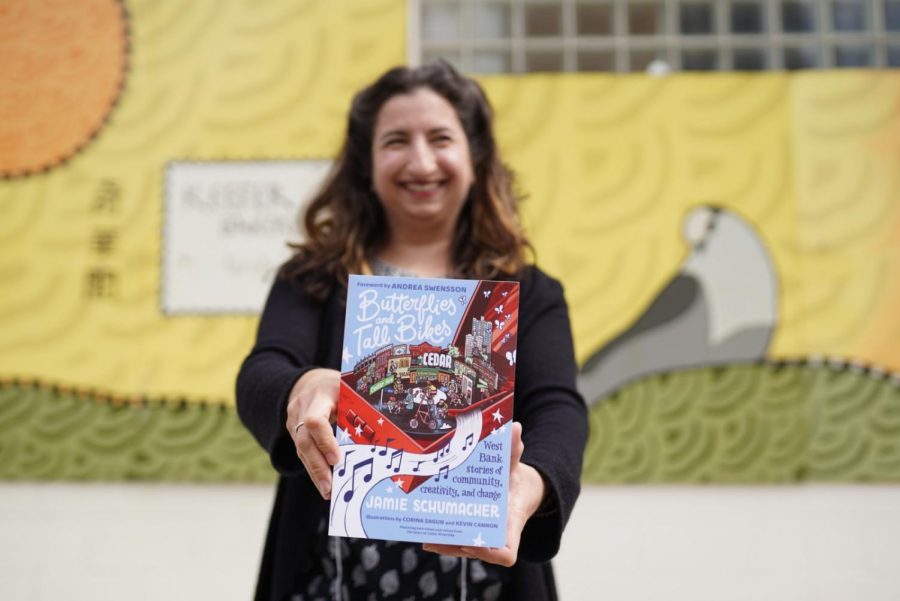Jamie Schumacher, the former executive director of the West Bank Business Association and University alum, spent the past year writing “Butterflies and Tall Bikes,” a love letter to the West Bank, with stories from West Bank residents, business owners and creatives themselves. Her book comes out May 18, so A&E spoke with Schumacher about her writing process, the West Bank and the impetus behind “Butterflies and Tall Bikes.”
What was the writing process like for “Butterflies and Tall Bikes?”
When you write something, you’re innately centered in your experience, but with this one, I really wanted to be more intentional and actually just interview people and have their voices and stories in there. I shared all the interviews back with folks and let them make edits to make sure I captured what they said correctly. What I wanted to do with this book is really lift up, especially for the residents, what they want. Cedar-Riverside can get neglected sometimes in positive news or even in just city policy, it can get overlooked. And so a lot of my job and my passion and my history has been just advocating for what the neighborhood wants, and this book was an opportunity to lift up some of those voices.
Your book features stories from everybody in the West Bank/Cedar-Riverside neighborhood, from residents to business owners. How did you choose which stories would be highlighted in the book?
One way of putting it would be diversity from every angle. We have residents, we have businesses, we have folks that currently live in the neighborhood, we have folks that used to live in the neighborhood. It’s just a mix of people that as we kind of created this timestamp and wrote this love letter to the neighborhood, it really was like a 360 view.
One of the things I noticed while I was reading was how I feel like your book really does provide this portrait of a neighborhood, even when we can’t necessarily spend so much time in that neighborhood because of COVID-19 and closures and everything. Through your stories and conversations, the reader is meeting these people and almost having that exchange that you would have if you met these people in person on the West Bank, and that’s something I really liked.
That makes me really happy because as I wrote it, I wanted to make sure that it was sensory. When you go to a new place, your senses overwhelm you and that’s part of the beauty of travel — and even just explicitly experiencing a neighborhood.
Our senses are still muted — literally and figuratively — because we’re online, and then when we’re out and about, we’re wearing masks, and so I really tried to be deliberate about having a creative piece that captures the sensory experience.
Speaking of senses, I did not know before reading that the Southern Theater was haunted. When I read “Ghosts and Muses,” I didn’t realize there were haunted buildings on the West Bank.
Oh, there’s many. When I started chatting with other folks from other theater companies that I hadn’t met before, they were like, “Oh my gosh, the Southern is totally haunted.” One time I was there doing the lighting rigging and there’s kids laughing upstairs; and I’ve talked to other people who don’t know each other, who have been in the Southern for separate things, and that’s what they say every time.
What would you like readers to take away from “Butterflies and Tall Bikes?”
I know that Merrie [Benasutti] talks about this a little bit in her interview where she’ll work with students who have sometimes a perception of Cedar-Riverside that is like the West Bank is unsafe, but that’s just fundamentally untrue.The West Bank is such a safe neighborhood. And there’s great restaurants and there’s great people and there’s amazing art. I think if people can read this book and feel a little bit like a regular and come to the West Bank and support the businesses and break that barrier a little bit, that’s great.









Richard Turnbull
May 13, 2021 at 9:07 am
Re: “Haunted,” the number of cultures on this third planet from the local sun which accept some form of the concept of reincarnation, or the transmigration of souls, as well as the number of famous writers, philosophers, musicians, artists, and even scientists, who also have recounted experiences which suggest such theories are correct, is worth exploring.
It cannot be meaningfully dismissed as “woo” or merely wishful thinking, until you have personally explored the vast literature on the subject.
Two suggestions for reading: Cosmic Consciousness, by Richard Maurice Bucke, M.D., and Golf in the Kingdom, by Esalen Institute co-founder Michael Murphy. As it’s not likely anyone can arrange a scientifically foolproof experiment in the Southern Theater, complete with all the paraphenalia necessary to rule out hoaxes and bogus accounts, you could also attend a play or other event there as well, of course.
This website is now using the “Drag your images here” nonsense to lazily disallow readers from contributing links etc., but if you also search “The Future of the Body by Michael Murphy,” a massive amount of material related to naturally induced “psychedelic” states of consciousness, yogic meditation, psychokinesis, precognition, healing, and telepathy (!) will result.